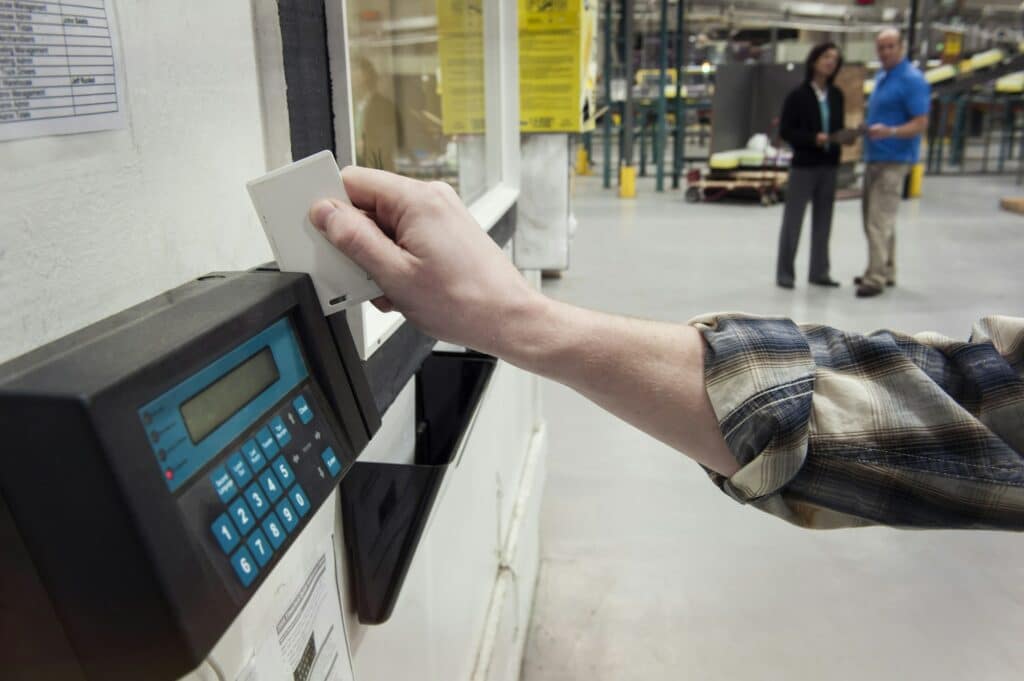Did you know that businesses that track employee hours using apps experience a 15% increase in productivity? Tracking employee hours is not just about monitoring attendance; it goes beyond that.
These apps, which streamline time tracking processes, provide real-time monitoring and accountability, helping managers identify time wasters and distractions.
But that’s not all. By optimizing workforce scheduling, enhancing project planning, and improving employee productivity, track employee hours app can boost overall team efficiency and success.
So, how exactly do employee hours tracking apps achieve all this? Let’s explore the ways in which they can become a valuable ally for managers in enhancing productivity and driving success.
Key Takeaways
- Employee hours tracking apps streamline time tracking and monitoring, increasing productivity by 15%.
- These apps help identify and address inefficiencies, promoting accountability and awareness of productivity.
- They optimize workforce management by providing real-time workload visibility and facilitating efficient shift swapping.
- Employee hours tracking apps enhance project planning and execution by tracking time spent on each project and task.
Streamlining Time Tracking Processes
Streamline your time tracking processes with the help of employee hours tracking apps. These innovative tools are designed to simplify and automate the task of monitoring your employees’ working hours. By using these apps, you can say goodbye to traditional methods such as manual timesheets or punch cards that are prone to errors and inefficiencies.

With employee hours tracking apps, you can effortlessly keep track of your team’s attendance, breaks, and overtime. The apps offer various features such as clock-in and clock-out functionalities, GPS tracking for remote workers, and automatic calculation of work hours. This not only saves you time but also ensures accuracy in recording and managing employee hours.
Moreover, these apps provide real-time visibility into your employees’ work patterns. You can easily monitor who’s currently working, who’s on a break, and who’s absent. This allows you to make informed decisions regarding scheduling and resource allocation, ultimately increasing productivity and minimizing downtime.
In addition to streamlining your time tracking processes, these apps also promote accountability among your employees. By having a transparent record of their working hours, they become more aware of their productivity and are motivated to meet deadlines and targets.
Real-time Monitoring and Accountability
With real-time monitoring and accountability, employee hours tracking apps provide a transparent record of your team’s working hours, fostering productivity and efficiency. These apps allow you to track the time your employees spend on different tasks and projects, giving you a clear picture of how their time is being utilized. By having access to real-time data, you can ensure that your team members are staying on track and meeting their deadlines.
With the help of these apps, you can easily see if any team members are falling behind or if there are any bottlenecks in the workflow. This allows you to take immediate action to address any issues and make necessary adjustments to improve productivity. Real-time monitoring also helps in identifying any potential time wasters and distractions, ensuring that your team is focused on their work.
Moreover, employee hours tracking apps provide a level of accountability for your team members. They know that their working hours are being tracked and recorded, which encourages them to stay focused and productive. This transparency helps create a culture of accountability within your team, where everyone is aware of their responsibilities and the importance of meeting deadlines.
Identifying Time Wasters and Distractions
To enhance productivity, employee hours tracking apps help identify and eliminate time wasters and distractions. These apps provide valuable insights into how employees spend their time during work hours, allowing managers to pinpoint activities that aren’t directly contributing to the organization’s goals. By tracking employee hours, managers can identify common time-wasting patterns and address them accordingly.

One major time waster that can be identified through these apps is excessive use of social media or personal internet browsing. While occasional breaks are essential for maintaining focus and productivity, excessive use of non-work-related websites can significantly impact employee performance. With the help of tracking apps, managers can identify employees who spend excessive time on non-work-related activities and address the issue promptly.
Another common distraction in the workplace is excessive meetings. Meetings, although necessary for effective communication and collaboration, can sometimes be a time-consuming affair. Employee hours tracking apps can help identify the frequency and duration of meetings, allowing managers to assess their impact on overall productivity. By analyzing the data, managers can then make informed decisions about the necessity and structure of future meetings, ensuring that valuable time isn’t wasted unnecessarily.
Additionally, employee hours tracking apps can help identify tasks or projects that are taking longer than expected. By analyzing the time spent on specific tasks, managers can identify bottlenecks or areas where employees may need additional support or training. This information can then be used to optimize workflows and improve overall efficiency.
Optimizing Workforce Scheduling
Employee hours tracking apps can help optimize workforce scheduling by providing valuable data on employee availability and workload. By utilizing these apps, you can streamline the scheduling process and ensure that your workforce is effectively utilized.
Here are four ways in which employee hours tracking apps can optimize workforce scheduling:
- Accurate availability information: These apps allow employees to input their availability, making it easier for managers to assign shifts based on actual employee availability. This reduces the risk of scheduling conflicts and ensures that the right employees are scheduled for the right shifts.
- Real-time workload visibility: With employee hours tracking apps, managers can easily see how many hours each employee has worked and how many hours they’ve remaining. This helps in distributing workload evenly and avoiding employee burnout.
- Efficient shift swapping: Employee hours tracking apps often include features that allow employees to request shift swaps with their colleagues. This ensures that shifts are covered even if someone can’t make it, without causing disruption to the schedule.
- Data-driven decision-making: These apps provide valuable insights into employee productivity and performance. By analyzing the data, managers can make informed decisions about workforce scheduling, such as identifying high-performing employees and adjusting shifts accordingly.
Enhancing Project Planning and Resource Allocation
Using employee hours tracking apps can greatly enhance project planning and resource allocation within your organization. These apps allow you to accurately track the amount of time your employees spend on each project and task. With this information, you can make more informed decisions when it comes to allocating resources for future projects.
By knowing exactly how much time is being spent on each project, you can better estimate the time and resources needed for similar projects in the future. This allows you to plan ahead and allocate resources more effectively, ensuring that each project is adequately staffed and that deadlines are met.
Additionally, tracking employee hours can help you identify any bottlenecks or inefficiencies in your project processes. If you notice that certain tasks are consistently taking longer than expected, you can investigate further and make necessary adjustments to improve efficiency. This can help you streamline your project planning and resource allocation, ultimately leading to increased productivity and cost savings.
Furthermore, these apps can also help with resource allocation on an individual level. By tracking how much time each employee is spending on different projects, you can ensure that workloads are balanced and that no one is overwhelmed or underutilized. This can improve employee satisfaction and morale, leading to higher productivity and better project outcomes.
Improving Employee Productivity and Performance
By improving employee productivity and performance, organizations can maximize their project outcomes and achieve greater success.
Here are four ways you can enhance productivity and performance in your team:
- Set clear goals and expectations: Clearly define what needs to be accomplished and communicate it to your team. When employees have a clear understanding of their objectives, they can focus their efforts and work towards achieving them more efficiently.
- Provide regular feedback and recognition: Regularly provide feedback on performance, both positive and constructive. Recognize and reward employees for their hard work and achievements. This not only motivates them but also helps them understand where they can improve.
- Foster a positive work environment: Create a positive and supportive work culture where employees feel valued and encouraged. Encourage collaboration, open communication, and teamwork. When employees feel comfortable and supported, they’re more likely to be engaged and productive.
- Invest in employee development: Offer training and development opportunities to help employees enhance their skills and knowledge. Provide resources and support for growth and learning. When employees have the tools they need to succeed, they can perform at their best.
Encouraging Work-Life Balance and Well-being
Creating a healthy work-life balance and promoting overall well-being is essential for maintaining your satisfaction and productivity. Encouraging a balanced lifestyle not only benefits you as an individual but also contributes to the success of the entire team. By prioritizing your well-being, you allow yourself to recharge and bring your best self to work every day.
One way to encourage work-life balance is by setting clear boundaries between work and personal life. Establishing specific working hours and sticking to them helps you avoid burnout and ensures that you have time for other important aspects of your life, such as family, hobbies, and self-care. It’s also important to take breaks throughout the day to rest and recharge, both physically and mentally.

Supporting your well-being goes beyond just balancing work and personal life. Employers can provide resources and programs that promote physical and mental health. This can include offering gym memberships, wellness programs, and mental health support services. Encouraging healthy habits, such as regular exercise and mindfulness practices, can significantly improve your overall well-being.
Remember that work-life balance isn’t a one-size-fits-all concept. What works for one person may not work for another. It’s important to find a balance that suits your individual needs and priorities. By prioritizing your well-being and maintaining a healthy work-life balance, you can enhance your overall satisfaction and productivity, benefiting both yourself and the team.
Boosting Overall Team Efficiency and Success
To boost overall team efficiency and success, it’s important to implement strategies that streamline workflows and maximize productivity. Here are four key strategies that can help you achieve this:
- Set clear goals and expectations: Clearly define the objectives and expectations for each team member. This will ensure that everyone is aligned and working towards a common goal. Regularly communicate progress and provide feedback to keep everyone on track.
- Foster effective communication: Encourage open and transparent communication among team members. Utilize collaboration tools and platforms to facilitate efficient communication and information sharing. Regular team meetings and check-ins can help address any challenges or roadblocks and ensure everyone is on the same page.
- Delegate tasks strategically: Assign tasks based on individual strengths and expertise. Effective delegation ensures that work is distributed evenly and that each team member can contribute their best. It also helps prevent burnout and promotes a sense of ownership and responsibility.
- Encourage collaboration and teamwork: Foster a culture of collaboration where team members can support and learn from each other. Encourage cross-functional collaboration and provide opportunities for team members to work together on projects. This not only enhances productivity but also promotes a positive and cohesive team dynamic.
Conclusion
So, if you want to boost productivity, improve employee performance, and enhance overall team efficiency, using employee time tracking apps is the way to go.
These apps streamline time tracking processes, provide real-time monitoring and accountability, help identify time wasters and distractions, optimize workforce scheduling, enhance project planning and resource allocation, and encourage work-life balance and well-being.
With these benefits, it’s clear that tracking employee hours is the manager’s ultimate ally in achieving success.
